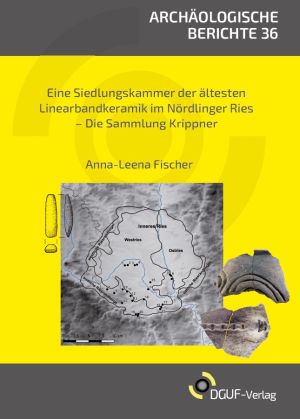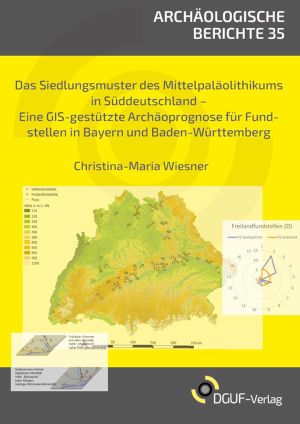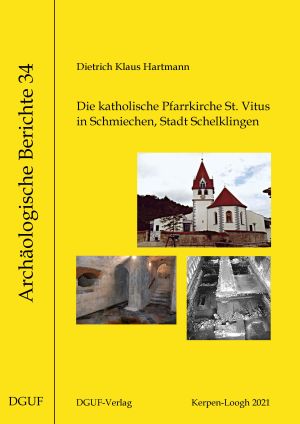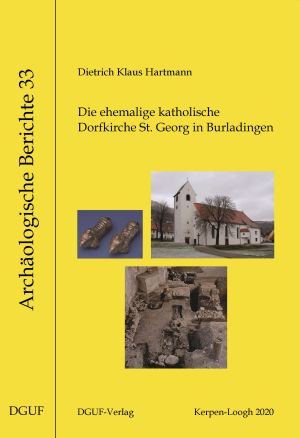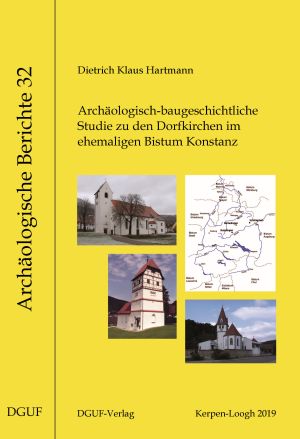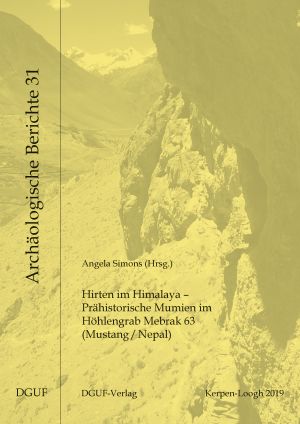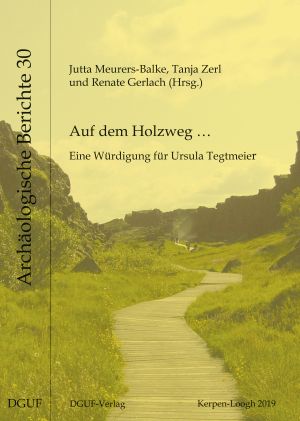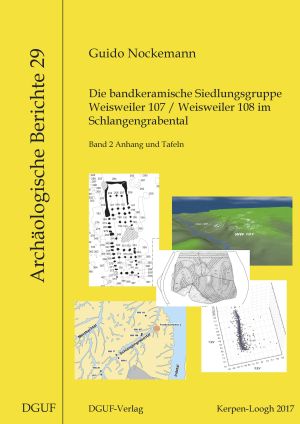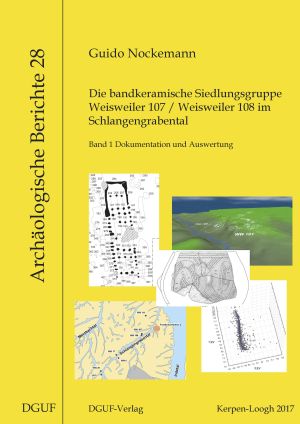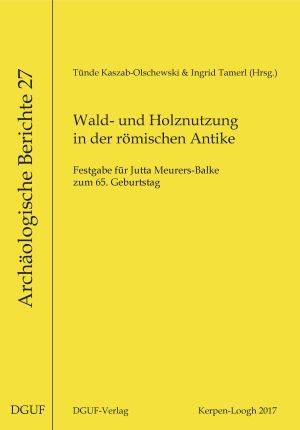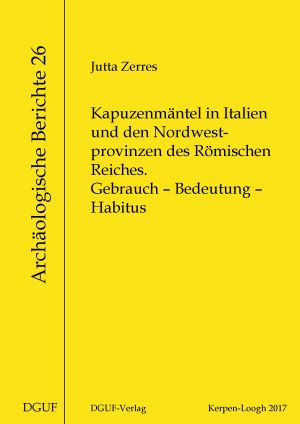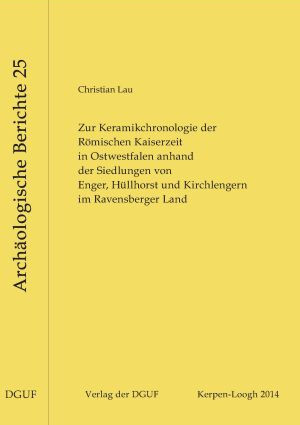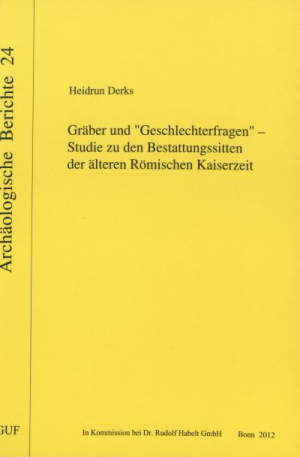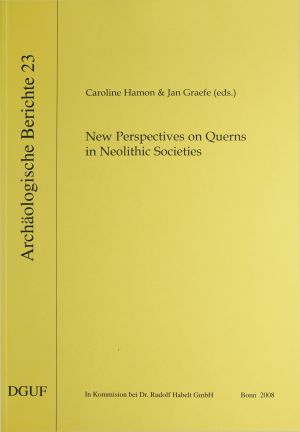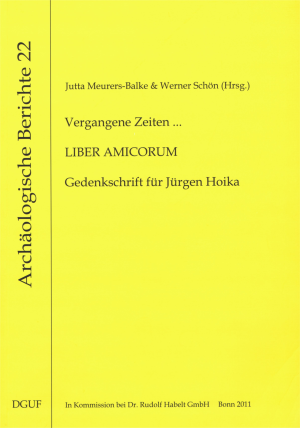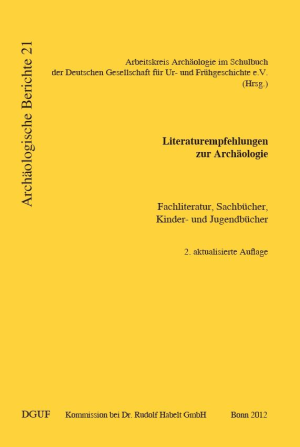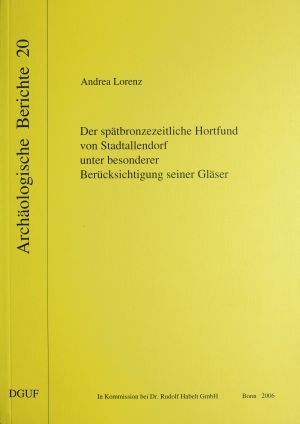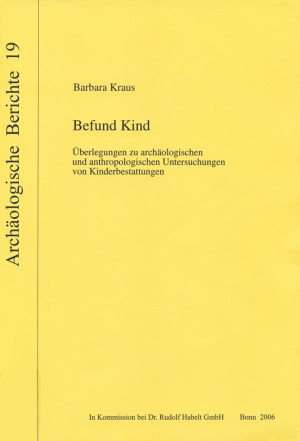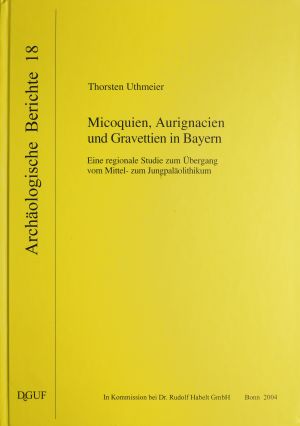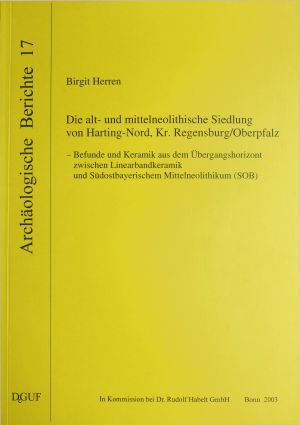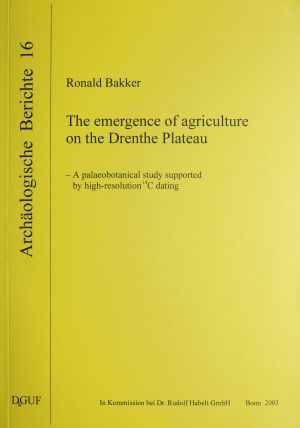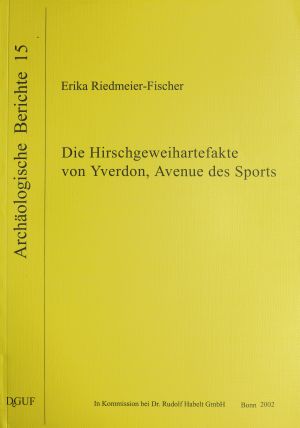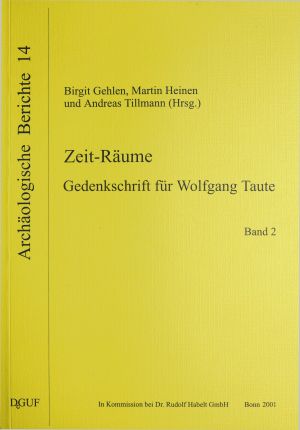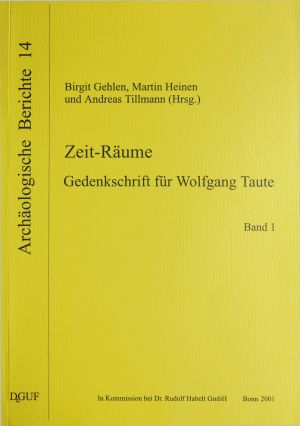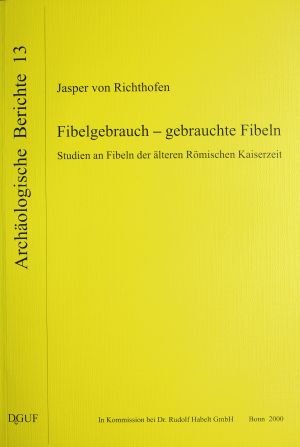Archäologische Berichte
Die „Archäologischen Berichte“ (Arch. Ber.) sind die Monografien der Deutschen Gesellschaft für Ur- und Frühgeschichte e.V. (DGUF). Sie erscheinen seit 1987 mit etwa einem Band pro Jahr. Ziel der DGUF bei der Gründung der Reihe war es, den Autoren eine Möglichkeit zu bieten, mit hoher Reichweite und wissenschaftsüblicher Qualitätssicherung preiswert und schnell publizieren zu können. Um dieses Ziel noch wirksamer erreichen zu können, erscheinen die Monografien seit Band 25 (2014) hybrid: in einer Druckausgabe und – in Kooperation mit der Universitätsbibliothek Heidelberg – zusätzlich online im Open Access. Wie die Zeitschrift der DGUF, die „Archäologischen Informationen“ nehmen auch die Monografien seit Band 25 bei Bedarf ergänzende Materialien und Open Data auf.
In einigen Bänden der Reihe wurden Arbeiten publiziert, die in der DGUF selbst entstanden sind, wie etwa die zweibändige Gedenkschrift für Wolfgang Taute (Arch. Ber. 14, 2001) oder die Literaturempfehlungen des DGUF-Arbeitskreises "Archäologie in Schule und Bildung" (Arch. Ber. 21, 2006). Die überwiegende Mehrheit der Bände entsteht jedoch aus guten Examensarbeiten und Dissertationen, die wir hier – kostengünstig für Autoren wie Leser – zeitnah zum Druck bringen. Die Werke erscheinen mit weltweiter Reichweite, gedruckt und im Open Access, samt Verlag und ISBN-Nummer in einer etablierten Reihe: Ein erheblicher Mehrwert gegenüber einer Publikation in Eigenregie, für Autoren wie für Leser.
Die Bände 1 bis 24 der Reihe wurden im Offset-Druck hergestellt, ab Band 25 erfolgt der Druck der Bücher im Print-on-Demand-Verfahren. Die noch als gedrucktes Exemplar lieferbaren Bände sind einschließlich der Preise auf der Website der DGUF ersichtlich und können bei der DGUF bestellt werden: verlag@dguf.de

Herausgeber
Priv.-Doz. Dr. Frank Siegmund
Dr. Werner Schön
Diane Scherzler M.A.
Dr. Birgit Gehlen
Internet: Redaktionswebsite
Bisher erschienen
Eine Siedlungskammer der Ältesten Linearbandkeramik im Nördlinger Ries – Die Sammlung Krippner
Das Nördlinger Ries weist bereits am Beginn der Jungsteinzeit um 5400 v.Chr. mit 16 nachgewiesenen Fundplätzen eine dichte Besiedlung auf. Zudem liegt dort mit dem Fundplatz Enkingen einer der ältesten Plätze der Linearbandkeramik außerhalb ihres Ursprungsgebietes in Transdanubien. Im vorliegenden Buch werden die von Franz Krippner, einem passionierten Hobbyarchäologen, entdeckten Fundstellen ausführlich vorgestellt, ihre Funde wissenschaftlich ausgewertet, die sozialen und ökonomischen Netzwerke untersucht und ein Besiedlungsmodell erstellt. Anschließend wird der Übergang zur nachfolgenden Stufe Flomborn analysiert, bevor das Buch mit einem Ausblick auf die Besiedlung Mitteleuropas am Beginn der Jungsteinzeit schließt.
Zugehörige Forschungsdaten: https://doi.org/10.11588/data/FD7DTS
Das Siedlungsmuster des Mittelpaläolithikums in Süddeutschland: Eine GIS-gestützte Archäoprognose für Fundstellen in Bayern und Baden-Württemberg
Die vorliegende Studie untersucht das Siedlungsverhalten und die Raumnutzung des Neandertalers anhand der Lageparameter von mittelpaläolithischen Höhlen- und Freilandstationen in Süddeutschland. Methodisch arbeitet die Autorin mit dem "Weighted Layer Approach" (WLA) – einer Variante der multiplen linearen Regression. In das Modell gehen u.a. die Höhe über Normalnull, die Hangneigung, die Ausrichtung und die Distanz zum nächsten Fließgewässer ein. Diese Parameter werden mit geologischen Faktoren wie z.B. der Verbreitung pleistozäner Böden, dem Vorkommen eines Kalksteingebirges mit Höhlen und der Ausdehnung der pleistozänen Eisvorstöße in Beziehung gesetzt. Aus den transparent gewichteten Daten errechnet Wiesner ein Archäoprognose-Modell, das in detaillierte Prognosekarten für die Wahrscheinlichkeit des Vorhandenseins bislang noch unentdeckter mittelpaläolithischer Fundstellen im untersuchten Raum mündet. Die Arbeit wurde 2021 von der DGUF mit dem Deutschen Studienpreis für Archäologie ausgezeichnet.
Die katholische Pfarrkirche St. Vitus in Schmiechen, Stadt Schelklingen
Die katholische Pfarrkirche St. Vitus im Ortsteil Schmiechen, Stadt Schelklingen (Alb-Donau-Kreis), ist in ihrem heutigen Erscheinungsbild eine Mischung verschiedener Epochen, von der Gotik bis zur Moderne. Die im Zuge einer Neugestaltung und Erweiterung 1990 und 1992 vorgenommenen archäologischen Untersuchungen wiesen eine Reihe von Vorgängerbauten nach, deren frühester sich ins 9. Jahrhundert datieren lässt. Dem ersten Kirchenbau, der seinerseits auf einem bereits bestehenden Friedhof und auf Fundamentresten unbekannter Zeitstellung errichtet wurde, folgten mehrere hoch- und spätmittelalterliche Bauphasen, bevor die Kirche in der Gegenwart durch seitliche Anbauten stark erweitert wurde. Eine Besonderheit für eine Kirche im ländlichen Raum ist die im 12. Jahrhundert im Rahmen einer Erweiterung errichtete kleine tonnengewölbte Krypta. Die während der Grabung im Kircheninneren erfassten Funde,
insbesondere die Keramik, sind eine wertvolle Ergänzung des bisher für die betreffende Region eher spärlich vorhandenen Materials. Damit ist die vorliegende Untersuchung ein wichtiger Baustein für die Erforschung der ländlichen Kirchenlandschaft des südöstlichen Baden-Württembergs.
Die ehemalige katholische Pfarrkirche St. Georg in Burladingen
Die ehemalige Pfarrkirche St. Georg in Burladingen auf der Zollernalb (Baden-Württemberg) ist in ihrem heutigen Erscheinungsbild ein Bau des Spätbarocks. Die im Jahr 1982 vorgenommenen archäologischen Untersuchungen wiesen jedoch eine Reihe von Vorgängerbauten nach, deren frühester sich in das 8. Jahrhundert datieren lässt. Mehr als drei Jahrzehnte nach der Ausgrabung erfolgt in diesem Band eine detaillierte Auswertung. Danach kann in Burladingen eine für die schwäbischen Alb typische Geschichte und Bauabfolge einer ländlichen Kirche nachgewiesen werden. Am Anfang steht im 8. Jahrhundert ein einfacher frühmittelalterlicher Kirchenbau, der seinerseits auf einem bereits bestehenden Friedhof errichtet wurde. Es folgen mehrere hoch- und spätmittelalterliche Bauphasen, bevor in der frühen Neuzeit ein grundlegender Neubau zum heutigen Aussehen der Kirche führte. Die für eine Kirchengrabung ungewöhnlich große Anzahl an Funden – insbesondere Keramik – bereichert das für diesen Raum bislang eher spärlich bekannte Material. St. Georg in Burladingen ist ein wichtiger Mosaikstein für die Erforschung der ländlichen Kirchen im südöstlichen Baden-Württemberg, worüber der Autor im Jahr 2019 eine zusammenfassende Übersicht veröffentlicht hat.
Archäologisch-baugeschichtliche Studie zu den Dorfkirchen im ehemaligen Bistum Konstanz
Der Osten des ehemaligen Bistums Konstanz (ca. 585 bis 1821) ist eine auch heute noch weitgehend ländlich geprägte Region mit einer reichen, bis auf das Frühmittelalter zurückgehenden Kirchenlandschaft. Im Laufe der letzten Jahrzehnte wurden an vielen dieser Kirchen archäologische Untersuchungen vorgenommen, deren Ergebnisse allerdings bislang nicht allgemein verfügbar waren. Der vorliegende Band gibt für das Gebiet des Regierungsbezirks Tübingen eine vollständige Übersicht über diese Forschungen.
Die Auswertung vergleicht im Detail die unterschiedlichen Entstehungsbedingungen der Kirchen. Neben der Aussagekraft der verschiedenen Bauformen wird auch das Umfeld der Kirchen genauer betrachtet. Ein besonderes Augenmerk gilt dabei der Existenz zugehöriger frühmittelalterlicher Siedlungsspuren. Weiterhin wird untersucht, inwieweit lokaler klösterlicher Besitz Einfluss auf die Bauentwicklung nimmt. Das Ergebnis ist ein umfassender Überblick über die frühe Entwicklung des Kirchenbaus innerhalb einer geschlossenen historischen Landschaft. In drei Folgebänden dieser Reihe werden die Kirchen St. Georg in Burladingen, St. Vitus in Schmiechen und St. Peter und Paul in Nusplingen, die den Ausgangspunkt dieser Untersuchung bildeten, ausführlich vorgestellt werden.
Zugehörige Forschungsdaten finden Sie unter nachstehendem Open Data-Link:
https://doi.org/10.11588/data/ENNK5V
Hirten im Himalaya – Prähistorische Mumien im Höhlengrab Mebrak 63 (Mustang/Nepal)
In diesem Band wird die vollständige Publikation der Ergebnisse der archäologischen Ausgrabung in der prähistorischen Grabhöhle Mebrak 63 im Dzong-Tal, einem Hochtal des Himalaya in Nepal, vorgelegt.
In zehn Kapiteln wird von den 15 Autorinnen und Autoren die Grabung und die Auswertung des komplexen Grabungsbefundes und des Fundmaterials dargestellt. Der Anhang dient der Vorlage der Primärdaten und umfasst Tabellen, Fundkatalog und Tafelteil. In der Zusammenarbeit von Archäologie, Anthropologie, Textilarchäologie, Archäobotanik, Archäozoologie und Dendroarchäologie wurde es möglich, die Bedeutung des prähistorischen Höhlengrabs weitgehend zu entschlüsseln und den Menschen, die im letzten vorchristlichen Jahrtausend in der Kollektiv-Grabhöhle bestattet wurden, nahe zu kommen. Die Lebensweise dieser Menschen sowie ihre Tausch- und Handelsverbindungen konnten durch die Untersuchungen dieses – in seiner Erhaltung bislang einmaligen – Befundes rekonstruiert werden.
Auf dem Holzweg … Eine Würdigung für Ursula Tegtmeier
Im vorliegenden Band sind Beiträge von 36 AutorInnen zu verschiedenen Themenbereichen aus Archäologie, Archäobotanik, Archäozoologie, Dendroarchäologie und Experimenteller Archäologie zu Ehren von Dr. Ursula Tegtmeier zusammengetragen worden. Das breite Spektrum der Beiträge spiegelt die vielfältigen wissenschaftlichen Interessensgebiete der Jubilarin wider sowie die engen Kontakte, die Ursula Tegtmeier zu KollegInnen aus unterschiedlichen archäologischen Disziplinen pfegt.
Die bandkeramische Siedlungsgruppe Weisweiler 107 / Weisweiler 108 im Schlangengrabental: Band 2. Anhang und Tafeln
Die Aldenhovener Platte liegt seit über 40 Jahren im Fokus der Bandkeramik-Forschung. Im Vorfeld der rheinischen Braunkohletagebaue wurden und werden zahlreiche Grabungen und Prospektionen durchgeführt. Dieses Buch beschäftigt sich mit der Auswertung der archäologischen Funde und Befunde der bandkeramischen Siedlungsgruppe Weisweiler 107/Weisweiler 108 im Schlangengrabental der Aldenhovener Platte. Ziel der hier vorgelegten Untersuchung ist zum einem die Dokumentation und Vorlage der bandkeramischen Hinterlassenschaften und zum anderen die Herausarbeitung der Besonderheiten und Charakteristika der Siedlungsgruppe Weisweiler 107/Weisweiler 108 sowie die Klärung ihrer kulturhistorischen Position und Funktion in der rheinischen Bandkeramik. Hierzu werden ihre Hinterlassenschaften untersucht und mit anderen Siedlungen verglichen. Des Weiteren wird die Chronologie der Siedlungsgruppe vorgestellt und ihre Rolle in verschiedenen Netzwerken (Keramikverzierungen, Weitergabe von Silexartefakten etc.) analysiert. Damit schließt diese Arbeit eine Lücke, denn nun liegen alle bisher bekannten bandkeramischen Siedlungen im Schlangengrabental vor und werden in dieser Arbeit zusammenfassend betrachtet. Band 2 dokumentiert die Datengrundlagen der Untersuchungen.
Band 1 stellt die Analysen und ihre Ergebnisse vor.
Die bandkeramische Siedlungsgruppe Weisweiler 107 / Weisweiler 108 im Schlangengrabental: Band 1. Dokumentation und Auswertung
Die Aldenhovener Platte liegt seit über 40 Jahren im Fokus der Bandkeramik-Forschung. Im Vorfeld der rheinischen Braunkohletagebaue wurden und werden zahlreiche Grabungen und Prospektionen durchgeführt. Dieses Buch beschäftigt sich mit der Auswertung der archäologischen Funde und Befunde der bandkeramischen Siedlungsgruppe Weisweiler 107/Weisweiler 108 im Schlangengrabental der Aldenhovener Platte. Ziel der hier vorgelegten Untersuchung ist zum einem die Dokumentation und Vorlage der bandkeramischen Hinterlassenschaften und zum anderen die Herausarbeitung der Besonderheiten und Charakteristika der Siedlungsgruppe Weisweiler 107/Weisweiler 108 sowie die Klärung ihrer kulturhistorischen Position und Funktion in der rheinischen Bandkeramik. Hierzu werden ihre Hinterlassenschaften untersucht und mit anderen Siedlungen verglichen. Des Weiteren wird die Chronologie der Siedlungsgruppe vorgestellt und ihre Rolle in verschiedenen Netzwerken (Keramikverzierungen, Weitergabe von Silexartefakten etc.) analysiert. Damit schließt diese Arbeit eine Lücke, denn nun liegen alle bisher bekannten bandkeramischen Siedlungen im Schlangengrabental vor und werden in dieser Arbeit zusammenfassend betrachtet. Band 1 stellt die Analysen und ihre Ergebnisse vor.
Band 2 dokumentiert die Datengrundlagen der Untersuchungen.
Wald- und Holznutzung in der römischen Antike: Festgabe für Jutta Meurers-Balke zum 65. Geburtstag
Holz war seit prähistorischen Zeiten ein wichtiger, ja unentbehrlicher Rohstoff mit vielfältigen Arten der Verwendung. Dies gilt im Besonderen auch für die Römerzeit, der dieser Band im Schwerpunkt gewidmet ist. Allerdings wird der aktuelle Stand der Forschungen zum Holz seiner wirklichen Bedeutung in der antiken Lebenswelt immer noch nicht gerecht. Dies ist leicht erklärlich – Holz hat sich nur in den wenigsten Fällen im Boden erhalten und wurde in den schriftlichen Quellen wegen seiner Selbstverständlichkeit im täglichen Leben nur nebenbei genannt.
Jutta Meurers-Balke, der dieser Band gewidmet ist, und ihr Team vom Labor für Archäobotanik der Universität zu Köln haben sich in zahlreichen Arbeiten um die Rekonstruktion der Waldgeschichte zur Römerzeit sowie die Dokumentation und Interpretation von Pflanzen- und Holzfunden aus der römischen Antike verdient gemacht. Zu Ehren von Frau Meurers-Balke fand im Oktober 2014 unter Leitung der beiden Herausgeberinnen eine internationale Tagung zum Thema “Wald- und Holznutzung in der römischen Antike” auf dem Rheinbacher Campus der Landwirtschaftlichen Fakultät der Universität Bonn statt. Mit dem vorliegenden Band, in dem die meisten der dort gehaltenen Vorträge sowie die Laudatio von A. J. Kalis anlässlich der Verabschiedung von Jutta Meurers-Balke vorgelegt werden, wird das immense historische Potenzial römischer Holzfunde und botanischer Reste in eindrucksvoller Weise erkennbar.
Kapuzenmäntel in Italien und den Nordwestprovinzen des Römischen Reiches: Gebrauch – Bedeutung – Habitus
Kapuzenmäntel waren in römischer Zeit wegen ihrer Wetterfestigkeit geschätzte und weit verbreitete Kleidungsstücke. Die vorliegende Studie beleuchtet mehr als die gängigen Fragen altertumskundlicher Analysen wie Typologie, Chronologie,
Material und Verbreitung, sondern sie fokussiert auf einen bislang wenig beachteten Aspekt dieses Alltagsgegenstandes: seine Rolle innerhalb der gesellschaftlichen Kommunikation. Das historische und archäologische Quellenmaterial wird im
Hinblick auf folgende Fragen analysiert: Gibt es Personen, zu deren Habitus (im Sinne des französischen Soziologen P. Bourdieu) Kapuzenmäntel zählen? Welche Personen(-gruppen) lassen sich identifizieren? Verwenden sie dabei spezielle
Formen von Mänteln? In welchen Situationen tragen sie das Kleidungsstück und welche Botschaften transportieren sie damit? Woher stammen die verwendeten Bedeutungszuweisungen an die Mäntel? Wie gestaltet sich der Umgang der Akteure
damit? Das Untersuchungsgebiet der Studie sind Italien und die Nordwestprovinzen des römischen Reiches in der Zeit der späten Republik bis in die Spätantike.
Zur Keramikchronologie der Römischen Kaiserzeit in Ostwestfalen anhand der Siedlungen von Enger, Hüllhorst und Kirchlengern im Ravensberger Land
Die in den 1930er-Jahren durch Rafael von Uslar erarbeitete und bis heute gültige Typologie und Chronologie der rhein-weser-germanischen Keramik (1.–3. Jh. n. Chr.) erfährt in diesem Buch eine gründliche Revision, wobei die zugrunde liegenden Fundkomplexe mithilfe einer Seriation (Korrespondenzanalyse) geordnet werden. Den Ausgangspunkt der Studie bilden die vollständige Vorlage, differenzierte Aufarbeitung und Typisierung der Keramik von drei kaiserzeitlichen Siedlungen in Ostwestfalen – Enger, Hüllhorst und Kirchlengern – sowie die Re-Analyse verwandter Keramik zahlreicher bereits veröffentlichter Komplexe, die ebenfalls zumeist von Siedlungen stammen. Die auf diesem Weg erstellte Chronologie erlaubt es nun, Siedlungen der Römischen Kaiserzeit genauer zu datieren als bisher. Auf Grundlage der Keramik wird für die drei Siedlungen Enger, Hüllhorst und Kirchlengern die Abfolge der Häuser und Nebengebäude skizziert und datiert sowie eine Besiedlungsgeschichte der drei Orte rekonstruiert.
Zugehörige Forschungsdaten finden Sie unter nachstehendem Open Data-Link:
Gräber und ‚Geschlechterfragen‘: Studie zu den Bestattungssitten der älteren Römischen Kaiserzeit
Männerfriedhof, Frauenfriedhof oder "optische" Täuschung? Männlich oder weiblich? Kulturelles Phänomen oder quellenbedingter Trugschluss? So lauten die Fragen, die die Untersuchung der Gräber und Gräberfelder der älteren Römischen Kaiserzeit zwischen Elbe und Oder seit dem 19. Jahrhundert begleiten.
Die vorliegende Studie fasst den Verlauf der bisherigen Diskussion zusammen und legt mit einer Untersuchung von über 7.000 Einzelbefunden von mehr als 300 Fundorten eine umfassende Betrachtung des seit gut 150 Jahren kontrovers erörterten Themas vor. Sie rückt überdies die möglichen Deutungen und Erklärungsmodelle in den Mittelpunkt der Betrachtung und greift hierfür weit über das Feld archäologischer Forschung hinaus.
Vergleichende Auswertung völkerkundlicher Studien
So erfolgt erstmals eine umfassend vergleichende Auswertung völkerkundlicher Studien zur Bedeutung des Geschlechts im Bestattungsritus, die Einblicke in die Gestaltungs- und Bedeutungsvielfalt geschlechtsspezifischer Bestattungssitten und das "Zusammenspiel" von Leben und Tod eröffnet, welches hierin Ausdruck findet.
Wechselspiel von politischen, wirtschaftlichen und sozialen Faktoren
In der Rückkopplung auf die ältere Römische Kaiserzeit wird deutlich, dass Vorstellungen des kulturellen "Geschlechts" die Bestattungssitten jener Zeit durchaus erheblich beeinflussten, aber keinesfalls allein bestimmten. Ungeachtet der zuweilen diffusen Quellenlage ist stattdessen ein komplexes Wechselspiel von politischen, wirtschaftlichen und sozialen Faktoren anzunehmen, um die regionale Vielfalt ebenso wie den beobachtbaren zeitlichen Wandel in den Beigabensitten zu interpretieren.
Zum anderen deutet einiges darauf hin, dass möglicherweise auch das in den Bestattungssitten Ausdruck findende Geschlechterkonzept unter dem Einfluss äußerer Faktoren - Bedrohung, Elitenbildung, wachsender "Wohlstand" - im Verlauf der älteren Römischen Kaiserzeit erheblichen Veränderungen unterlag.
New Perspectives on Querns in Neolithic Societies
Seit der Zeit der ersten neolithischen Gesellschaften wird das Korn der angebauten Kulturpflanzen mittels Mahlsteinen zu Mehl verarbeitet. Grundlage einer agrarischen Lebensweise stellt die Domestikation und Zucht von Tieren sowie der Anbau und die Verarbeitung von Kulturpflanzen dar. Erst innerhalb der vergangenen fünfzehn Jahre konnten grundlegende Aspekte der Pflanzenverarbeitung geklärt werden. Untersuchungen zu Mahl- und Schleifsteinen tragen zum Verständnis und Wissen neolithischer Wirtschaftsformen und sozialer Organisation bei. Durch neue, mehr oder weniger regionale Studien wurden neue Daten gewonnen, die Aussagen zu Austauschsystemen der Rohmaterialien, der wirtschaftlichen Grundlagen oder auch der sozialen und symbolischen Bedeutung der Mahlsteine ermöglichen.
Die hier veröffentlichten Artikel resultieren aus einer Sitzung, die im Rahmen des 13. Jahrestreffens der European Association of Archaeologists (EAA) im September 2007 in Zadar (Kroatien) stattgefunden hat.
Die Aufsätze zeigen, dass durch einen globalen Überblick zu Mahl- und Schleifsteinen wichtige Beiträge für die Interpretation des Status und der Funktion eines Siedlungsplatzes geliefert werden können.
Vergangene Zeiten - LIBER AMICORUM: Gedenkschrift für Jürgen Hoika
Entsprechend der Forschungsinteressen von Jürgen Hoika versammelt der Band vor allem Beiträge zum Mesolithikum und Frühneolithikum und bietet auch wertvolle Materialvorlagen. Besonders erwähnen möchten wir den Aufsatz von Sönke Hartz u. a., in dem die Fundkontexte von vier durchlochten donauländischen Äxten eingehend analysiert werden, deren Rohmaterial aus Böhmen stammt. Diese Äxte kamen auf der Wagrischen Halbinsel zwischen 4900-4100 v. Chr. in Siedlungen der Ertebølle-Kultur in den Boden, wo sie offenbar nach einer Verwendung als Prestigegüter deponiert wurden.
Marjorie de Grooth präsentiert einen willkommenen Merkmalkatalog zur makroskopischen Unterscheidung verschiedener Feuersteinvarietäten aus dem Raum Maastricht, Tongern, Liège und Aachen; ergänzend sind auf der dem Band beigefügten CD typische Stücke in guten Farbfotos dokumentiert.
Birgit Gehlen und Werner Schön erschließen mit einer akribischen Fundvorlage die Sammlung Graf Vojkffy (1879-1970), der im Westallgäu zahlreiche vor allem mesolithische Plätze absammelte. Exemplarisch zeigt diese Studie, wie Gewinn bringend die Analyse von Oberflächenfundplätzen und die enge Zusammenarbeit von ehrenamtlich Tätigen und Wissenschaftlern sein können.
Die der Printausgabe beigefügte CD ist der Kapitelübersicht als "Beilagen" angefügt.
Literaturempfehlungen zur Archäologie: Fachliteratur, Sachbücher, Kinder- und Jugendliteratur
Mit dieser Bibliographie möchte der DGUF-Arbeitskreis "Archäologie im Schulbuch" Schulbuchautoren, Lehrern, Museumspädagogen, Studierenden und interessierten "Laien" eine Zusammenstellung von Fachliteratur sowie Kinder- und Jugendliteratur an die Hand geben.
Das von Fachwissenschaftlern kommentierte, nach Epochen, Inhalten und teilweise auch nach Bundesländern gegliederte Verzeichnis zu Themen von der Altsteinzeit bis zum Mittelalter bildet ein übersichtliches Nachschlagewerk für alle, die einen leichten Zugang zur Ur- und Frühgeschichte Mitteleuropas suchen.
Der spätbronzezeitliche Hortfund von Stadtallendorf unter besonderer Berücksichtigung seiner Gläser
Der Hortfund von Stadtallendorf bei Marburg liegt isoliert am Nordrand der süddeutschen Urnenfelderkultur. Er zählt zu jenen Depots der Spätbronzezeit, die durch eine einzigartige Zusammensetzung auffallen. Diese zeichnet sich primär durch die große Typenvielfalt der deponierten Glasperlen aus.
Die vorliegende Studie untersucht die Perlen anhand von Mikrosonden-Analysen im Hinblick auf ihre chemische Zusammensetzung. So klären sich Fragen hinsichtlich der benutzten Rohstoffe und deren Mixtur sowie des kulturellen Ursprungs der Gläser. Darüber hinaus beinhaltet die Arbeit eine komplette Neuvorlage des 1943 entdeckten Fundes.
Befund Kind: Überlegungen zu archäologischen und anthropologischen Untersuchungen von Kinderbestattungen
Gräber gehören zu den wichtigsten Quellen in der Ur- und Frühgeschichtsforschung. Die Entscheidung, menschliche Überreste zu bergen und mit Blick auf ein bestimmtes archäologisches Erkenntnisinteresse auszuwerten, kann nur auf der Basis einer genauen Kenntnis naturwissenschaftlicher Methoden und ihren Möglichkeiten und Grenzen erfolgen. Gerade die Anwendung invasiver Verfahren erfordert besondere Sorgfalt.
Eine Modifizierung der Methoden, die bei der Befundung der Überreste von Erwachsenen praktikabel sind, reicht nicht aus, um die reifungsbedingt unterschiedliche Ausprägung befundbarer Merkmale (verstorbener) Kinder angemessen zu berücksichtigen.
Auch die Nutzbarkeit schriftlicher Quellen mittels Analogieschluss unterliegt bestimmten Kriterien, die den Problemen der Anwendbarkeit anthropologischer Methoden strukturell ähneln können.
Mit dem vorliegenden Überblick archäologischer und anthropologischer Verfahren zur Befundung physischer Überreste von Kindern und ihrer Bewertung soll ein Beitrag zur Methodologie geleistet werden.
Micoquien, Aurignacien und Gravettien in Bayern: Eine regionale Studie zum Übergang vom Mittel- zum Jungpaläolithikum
Bayern ist ein Schlüsselgebiet in der Diskussion des Übergangs vom Mittel- zum Jungpaläolithikum. Die in den immer eisfreien Korridor zwischen skandinavischem und alpinem Eisschild eingebettete Donauebene verbindet als ein wichtiger eiszeitlicher Wanderungsweg die reichen Fundregionen des späten Mittel- und frühen Jungpaläolithikums in Südwesteuropa einerseits und Mittel- und Osteuropa andererseits. Mit Fundstellen des spätesten Mittelpaläolithikums, des frühesten Aurignaciens und des Gravettiens bietet sich hier die einmalige Gelegenheit, bisherige Erklärungsmodelle für eine der spannendsten Kapitel der Menschheitsgeschichte - der Ausbreitung des modernen Menschen - zu überprüfen.
Die alt- und mittelneolithische Siedlung von Harting-Nord, Kr. Regensburg/Oberpfalz: - Befunde und Keramik aus dem Übergangshorizont zwischen Linearbandkeramik und Südostbayerischem Mittelneolithikum (SOB)
Im Unterschied zu allen bis dato untersuchten Fundplätzen Niederbayerns ist in Harting-Nord der Übergang von Alt- zu Mittelneolithikum erfasst. Im Altneolithikum stehen die Hausgrundrisse und Gefäße noch ganz in linearbandkeramischer Tradition.
Die Untersuchungen von Birgit Herren zeigen, dass sich mit zunehmendem Kontakt zu der in Böhmen und im Elbe-Saale-Gebiet entstandenen Stichbandkeramik entsprechende Kulturelemente auch in Harting-Nord niederschlagen: Der sukzessive, kontinuierliche Wandel von Linearbandkeramik zum älteren Südostbayerischen Mittelneolithikum (kurz SOB I) ist sowohl in den Hauskonstruktionen und den Gefäßformen als auch im Verzierungsstil anschaulich nachzuvollziehen. Die Siedlungsstruktur ändert sich hingegen nicht. Die neolithische Siedlung von Harting-Nord endet vor dem Einsetzen des regionalen Verzierungsstils im SOB II.
The emergence of agriculture on the Drenthe Plateau: A palaeobotanical study supported by high-resolution 14C dating
Für diese Studie wurden die Sedimente aus einem eiszeitlichen Pingorest in der Provinz Drenthe in den Niederlanden auf ihren Pollengehalt und ihre botanischen Makroreste hin untersucht. Auf der Basis von neun Pollenprofilen rekonstruiert der Autor die Vegetationsgeschichte vom Präboreal bis heute. Besonders berücksichtigt wird die Phase der Neolithisierung und der Beginn der Landwirtschaft. Auf der Grundlage von Pollendiagrammen aus der norddeutschen und niederländischen Altmoränen-Landschaft wird ein Schema erarbeitet, das den Verlauf ausgewählter Pollenkurven während des Neolithikums beschreibt.
Die sogenannte Neolithische Okkupationsperiode (Neolithic Occupation Period, NOP) wird in drei Phasen gegliedert, die drei verschiedene Formen der bäuerlichen Wirtschaft repräsentieren. Mit Hilfe hoch auflösender C14-Datierungen werden diese drei Phasen mit archäologischen Kulturen verbunden. Die Phase NOP1 wird von 4050 bis 3450 cal BC datiert. Sie ist durch geringe ackerbauliche Aktivitäten und Tierhaltung mit Laub- und Zweigfütterung charakterisiert. Sie fällt in die Zeit der Swifterband Kultur, deren Träger also die ersten Bauern auf dem Drenthe-Plateau gewesen sind. Für die Phase NOP 2, die mit der Trichterbecher Kultur verbunden werden kann, ist eine großräumige Viehhaltung charakteristisch. In der Phase NOP 3 dagegen betrieben die Menschen der Einzelgrab- und der Glockenbecher-Kultur ihre Landwirtschaft auf eher kleinen Arealen.
Die Hirschgeweihartefakte von Yverdon, Avenue des Sports
In der vorliegenden Arbeit werden die Geweihartefakte aus der endneolithischen Siedlung von Yverdon, Avenue des Sports, am Neuenburger See in der Westschweiz untersucht. Nach einführenden Kapiteln zum Forschungsstand und zu Herstellungstechniken sowie der Wertung der bestehenden Chronologien, werden die Funde vorgestellt und stratigrafisch ausgewertet. Die Hirschgeweihfartefakte aus Yverdon, die überwiegend in den Zeitraum zwischen 2750 und 2550 vor Christus gehören, bieten die Grundlage für die Betrachtung der endneolithischen Funde aus der Westschweiz im Vergleich mit denen der Ostschweiz und des Bodenseeraumes. Dabei wird im Westen der Einfluss der südfranzösischen Saône-Rhône-Kultur deutlich, während im Osten eine starke Assimilation an die Schnurkeramik erkennbar ist, was die Ergebnisse der bereits vorliegenden Keramik-Analysen eindrucksvoll bestätigt.
Zeit-Räume: Gedenkschrift für Wolfgang Taute. Band 2
Der zweite Band enthält Aufsätze zum eigentlichen Forschungsschwerpunkt von Wolfgang Taute, dem späten Paläolithikum, dem Mesolithikum und dem Altneolithikum in Nord- und Süddeutschland. Unter den zahlreichen hier vorgestellten Projekten, von denen eine ganze Reihe aus den Arbeiten von Wolfgang Taute hervorgegangen sind, nehmen die Ergebnisse der Untersuchungen zur La-Hoguette-Fundstelle von Stuttgart - Bad Cannstatt eine ganz zentrale Rolle ein.
Zeit-Räume: Gedenkschrift für Wolfgang Taute
In Band 1 sind Beiträge zu verschiedenen Bereichen der archäologischen Forschung zusammengestellt. Nach theoretischen Überlegungen zur Suche nach einer Wirtschaftsarchäologie sowie der Darstellung von Verfahren und Ergebnissen der C14-Analyse und der Dendrochronologie werden Probleme und Befunde vom Mittelpaläolithikum bis zur frühen Neuzeit in Deutschland thematisiert. Danach spannt sich der Bogen archäologischer und ethnoarchäologischer Untersuchungen von Nepal über die Levante nach Nord- und Westafrika und schließlich nach Amerika. Viele der hier vorgestellten Arbeiten sind durch Wolfgang Taute angeregt, betreut oder wohlwollend begleitet worden.
Fibelgebrauch — gebrauchte Fibeln: Studien an Fibeln der älteren Römischen Kaiserzeit
An Fibeln aus nord- und ostdeutschen Grabfunden der älteren Römischen Kaiserzeit sind häufig Gebrauchsspuren erkennbar. Sie sind nach Materialabtrag, Deformation und Reparatur zu unterscheiden. Eine Autopsie gestattet Einblicke in Kleidungs- und Trachtsitten während der ersten beiden nachchristlichen Jahrhunderte. Ferner erschließen sich grundlegende Erkenntnisse zur Chronologisierung ur- und frühgeschichtlicher Grabfunde.
Die Lage von Abriebstellen an den Fibeln weist mit Hilfe von bildlichen Darstellungen und Körpergrabbefunden auf Funktion und Tragweise der Fibeln hin. An der Intensität des Materialabtrags ist vor dem Hintergrund anthropologischer Analysen der in den Gräbern gefundenen Knochenreste die Umlaufzeit der Fundstücke erkennbar. Anhand von Zusammenfunden mehrerer Fibeln lassen sich Produktions- und Niederlegungszeiten bestimmter Formen herausstellen. Es ergeben sich daraus erhebliche Konsequenzen für die anerkannte absolute Zeitstellung der älterkaiserzeitlichen Funde.



